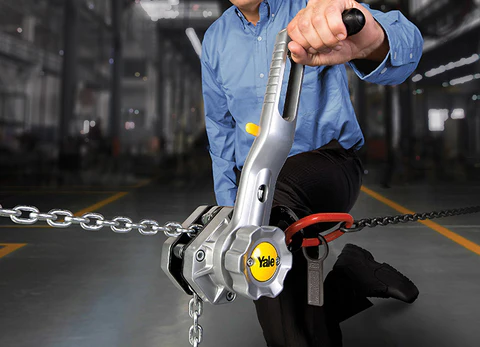The Best Guide to Choosing the Right Lifting Equipment for Your Needs
When it comes to safely and efficiently managing heavy loads, the right lifting equipment is essential. Whether you're working in construction, manufacturing, logistics, or any other industry that involves moving large objects, choosing the correct tools can make a big difference in both safety and productivity. This guide will walk you through the different types of lifting equipment available, how to select the best options for your needs, and what to consider when making your decision.

### Understanding Different Types of Lifting Equipment
Lifting equipment is designed to move heavy items with precision and control. Here are some of the most commonly used types:
- **Cranes**: These powerful machines are used across various industries, from construction sites to ports and factories. They come in different forms like tower cranes, mobile cranes, and overhead cranes, each suited for specific tasks.
- **Hoists**: Hoists are ideal for lifting and lowering loads using a drum or wheel. They can be manual, electric, or air-powered, and are often used in warehouses, maintenance areas, and manufacturing facilities.
- **Forklifts**: Essential for moving materials over short distances, forklifts are widely used in warehouses, distribution centers, and production plants. They come in electric, diesel, and gas models, each with its own advantages.
- **Winches**: Winches are mechanical devices used to pull or lift heavy objects. They are commonly found in marine, automotive, and construction environments.
- **Jacks**: Portable and versatile, jacks are used to lift vehicles, machinery, or other heavy objects. Hydraulic, bottle, and floor jacks are among the most common types.

### Factors to Consider When Choosing Lifting Equipment
Selecting the right equipment isn’t just about power—it’s also about matching the tool to your specific needs. Here are some key factors to keep in mind:
- **Load Capacity**: Always choose equipment that can handle more than your heaviest load. This provides a safety margin in case of unexpected weight changes.
- **Lift Height**: Make sure the equipment can reach the required height without compromising stability or safety.
- **Environment**: Some equipment is better suited for indoor use, while others are built for outdoor conditions. For example, electric hoists work well indoors, while diesel forklifts are more durable in harsh environments.
- **Usage Frequency**: If you’ll be using the equipment daily, invest in high-quality, long-lasting models that can withstand regular wear and tear.
- **Mobility Needs**: Decide whether you need a mobile solution or something that stays in one place. Mobile equipment offers flexibility, while stationary systems provide greater stability.
- **Safety Features**: Look for equipment with features like overload protection, emergency stop buttons, and proper guarding to reduce the risk of accidents.
### Maintenance and Compliance
Proper maintenance is crucial for the safe and reliable operation of lifting equipment. Regular inspections, timely servicing, and replacing worn parts can prevent breakdowns and ensure compliance with safety standards. In many regions, regulations such as LOLER (Lifting Operations and Lifting Equipment Regulations) in the UK require periodic checks. Staying compliant not only protects your workers but also helps avoid legal issues and fines.
### Conclusion
Choosing the right lifting equipment is more than just a technical decision—it's a critical factor in ensuring the success and safety of your operations. By understanding the different types of equipment, evaluating your needs, and prioritizing safety and durability, you can make an informed choice that supports your business goals. Don’t forget to maintain your equipment regularly and stay up to date with local regulations.
For expert advice on selecting the best lifting solutions tailored to your business, visit Lifting365. We’re here to help you achieve safer, more efficient lifting operations every day.
Shredding Blades Introduction
Shredding blades are essential components in shredding machines, playing a crucial role in the efficient processing of various materials.
Shredder Blade
The shredder blade is the core element of a shredding machine. It is designed with precision to cut and tear materials into smaller pieces. Shredder blades are typically made of high-quality materials such as hardened steel or special alloys to ensure durability and sharpness. These blades come in different shapes and sizes, depending on the specific requirements of the shredding application.
Industrial Shredder Blades
Industrial shredder blades are specifically designed for heavy-duty industrial applications. They are built to handle large volumes of materials and withstand the rigors of continuous operation. These blades are often made of stronger materials and have a more robust construction to ensure long service life in demanding industrial environments.
Blade For Shredder
The blade for shredder is carefully engineered to meet the specific needs of different shredding tasks. Whether it's shredding paper, plastic, metal, or other materials, the blade is designed to provide optimal cutting performance. Different types of blades may be used for different materials, with features such as serrated edges or special coatings to enhance shredding efficiency.
Shredder Blade Drawing
Shredder blade drawings provide detailed specifications and designs for manufacturing these essential components. These drawings help ensure accurate production and quality control of shredder blades. They typically include dimensions, materials, and manufacturing processes, allowing manufacturers to produce blades that meet the exact requirements of different shredding machines.
In conclusion, shredding blades, including shredder blades, industrial shredder blades, blades for shredder, and shredder blade drawings, are critical for the effective operation of shredding machines. These blades are designed to handle a wide range of materials and provide reliable shredding performance in various applications.
Shredder Blade,Industrial Shredder Blades,Blade For Shredder,Shredder Blade Drawing
Zigong Yibaijie , https://www.oz-yibaijie.com